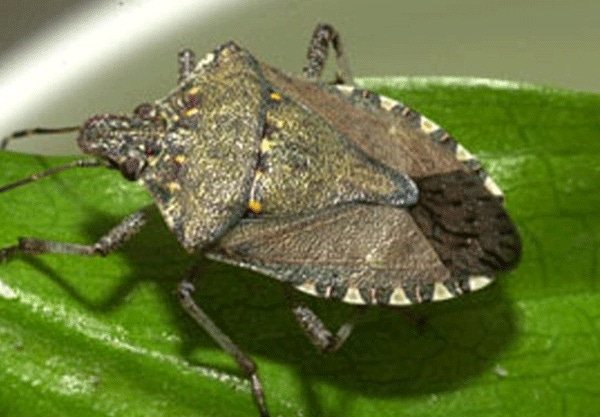September 30, 2010

Home owners in the upper Southeast and Mid-Atlantic states are learning what farmers have known for a few years now: Stink bugs are a real pain — and a smelly one at that.
A new species, the brown marmorated stink bug (Halyomorpha halys) is wreaking havoc in homes, vegetable gardens and to a lesser extent farms in the upper Southeast this year.
Though not the species most commonly associated with crop damage, the brown marmorated stink bug, which is often called the ‘Asian stinkbug’, can and does damage crops and is becoming a real nuisance to home owners in Virginia, Maryland, Delaware and Pennsylvania.
Kenneth Coney, a non-farming home owner in western Virginia says the little critters are just getting downright hard to live with these days.
“Here in northwestern Virginia, where I am, the stink bugs are my No. 1 home pest. The exterior walls of my house are black with them. A door or window can't be opened (at any hour) without 4 or 5 flying inside.
We have a vacuum cleaner designated just for them, but more control is needed. My local Praying Mantis population seems to either be ignoring them, or perhaps the stink bugs simply breed more than 3 or 4 Praying Mantis can eat,” Coney says.
Even politicians have gotten involved in trying to cope with the pests, which first showed up in the U.S. in the early and mid-1990s and was first documented in Pennsylvania.
Congressmen Roscoe Bartlett is acting to spur solutions to assist farmers in Maryland and other states facing devastating damage caused by the Asian stink bug, or the brown marmorated stink bug.
“I was introduced to the havoc being wreaked by the brown marmorated stink bug at a farm in my district during the first week in September. This week, I organized a formal briefing by USDA and regional farm experts as well as informal briefings for members and staff in the U.S. House of Representatives,” Brown says.
Perfect terrorist bug
“If you wanted to design a terrorist bug, it would have the features of the brown marmorated stink bug. I am working to find solutions to minimize the damage to crops this fall and in 2011. Its current classification as an unregulated pest is one barrier that I am working to address,” Bartlett concludes.
There are several different species of stink bugs causing major problems in crops, ranging from peaches to cotton. Though all are similar, managing them can be quite different.
In addition to the brown marmorated stink bug, or Asian stink bug, at least three other species are common to crops and other native host plants in the upper Southeast. Green stink bugs (Acrosternum hilare) and Southern green stink bugs (Nezara viridula) are similar, but different. And, both greens are different from brown stink bugs (Euschistus servus). And, now there is the brown marmorated stink bug.
The brown marmorated stink bug, an insect not previously seen on our continent, was apparently accidentally introduced into eastern Pennsylvania. It was first collected in September of 1998 in Allentown, but probably arrived several years earlier. It is now widespread in New Jersey, Maryland, Delaware, West Virginia, and Virginia. Smaller populations have been detected in Mississippi, Ohio, Oregon, and California.
While the threat to crops is still evolving, the bugs are firmly entrenched as household pests, creeping into homes for warmth and turning up everywhere. When startled or challenged, the bugs emit a foul odor, similar to the smell found in stink bugs attacking crops. In large enough numbers, these new pests can make a startling noise when challenged.
According to a report by the USDA task force, the bugs caused serious damage to apple, pear and peach crops in Maryland and West Virginia last year. Other crops are at risk because the bug has a broad palate.
A few farmers and more than a few homeowners have reported that the new stink bug is immune to insecticides commonly used to manage green, Southern green and brown stink bugs.
Virginia Tech entomologist and veteran director of Virginia’s Integrated Pest Management Program, Ames Herbert, says the Asian stinkbug is, “A recently introduced pest that is expanding its range at an amazingly rapid rate. It is attacking a large number of fruit, vegetable, ornamental and row crops, and is also found on a wide variety of trees, bushes and weeds. In Virginia, it has spread into many new counties now as far south as Virginia Beach.”
Little information
As to whether these newer stink bugs have developed resistance to commonly used insecticides, Herbert says, “This pest is so new we do not have a lot of information about what insecticides might work best for control. Studies are under way in many states and what we are hearing is not encouraging, that many of the standard stink bug control products may not be working very well.”
“So far, in Virginia, the brown marmorated stink bug has been primarily a problem in vegetable gardens attacking sweet corn, tomatoes, peppers and squash and is also causing havoc in apples, peaches, berry crops and grapes. Of course, we are getting many, many calls from homeowners from across much of the state as these critters move into buildings to over-winter.”
Herbert says, “This bug can be devastating to many crops (apples, peaches, berries, grapes, tomato, pepper, corn--and much more).”
“We were able to secure funding this year to conduct a statewide survey of soybean fields (soybean is a host crop for this bug in China) and we found it in soybeans in about a dozen counties…first time ever,” Herbert adds.
Of particular concern to the veteran Virginia Tech entomologist are reports (and some pictures) that indicate high thresholds of the new stink bug on okra. Okra is close kin to cotton, and if these reports are accurate, cotton in the upper Southeast could be at risk in coming years.
“These stink bug species, unlike any others with which I am familiar, aggregate in large numbers in over-wintering sites, similar to the lady beetle some years ago.
If these stink bugs are found in crops, growers should notify their local county Extension office. “Information on new infestations will help us understand how this pest is advancing and what crops may be at risk. Right now, we still have a lot of unknowns, but rest assured, this pest has our attention and a lot of resources will be directed to trying to figure out how best to manage it,” Herbert concludes.
Whether or not the brown marmorated stink bug is a sinister terrorist plot or just another troublesome insect species that has shown up in North America, the bottom-line is it needs to be managed.
Farmers and homeowners alike should contact their county Extension office, if they suspect the little varmints have shown up on their farm or in their home, then let the experts take it from there.
[email protected]
About the Author(s)
You May Also Like






